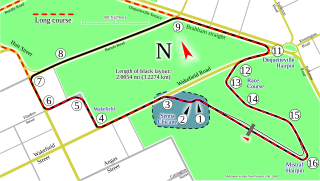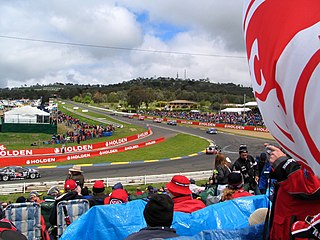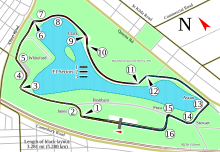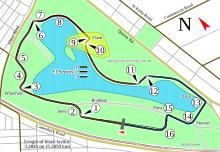
Circuit Zandvoort, known for sponsorship reasons as CM.com Circuit Zandvoort, previously known as Circuit Park Zandvoort until 2017, is a 4.259 km (2.646 mi) motorsport race track located in the dunes north of Zandvoort, the Netherlands, near the North Sea coast line. It returned to the Formula One calendar in 2021 as the location of the revived Dutch Grand Prix.

The Australian Grand Prix is an annual motor racing event which is under contract to host Formula One until 2035. One of the oldest surviving motorsport competitions held in Australia, the Grand Prix has moved frequently with 23 different venues having been used since it was first run at Phillip Island in 1928. The race became part of the Formula One World Championship in 1985. Since 1996, it has been held at the Albert Park Circuit in Melbourne, with the exceptions of 2020 and 2021, when the races were cancelled due to the COVID-19 pandemic. Before that, it was held in Adelaide.

The Bahrain International Circuit is a 5.412 km (3.363 mi) motorsport venue opened in 2004 and used for drag racing, GP2 Series, and the annual Formula One Bahrain Grand Prix. The 2004 Grand Prix was the first held in the Middle East. Beginning in 2006, Australian V8 Supercars raced at the BIC, with the event known as the Desert 400. However, the V8 Supercars did not return for the 2011 V8 Supercar season. 24 Hour endurance races are also hosted at BIC. The circuit has a FIA Grade 1 license. The circuit also has multiple layouts.

The Adelaide Street Circuit is a temporary street circuit in the East Parklands adjacent to the Adelaide central business district in South Australia, Australia.

Oran Park Raceway was a motor racing circuit at Narellan south west of Sydney, New South Wales, Australia which was operational from February 1962 until its closure in January 2010. The track was designed and started by George Murray and Jack Allen. Since its closure in 2010 it has been (re)developed into housing.

The Phillip Island Grand Prix Circuit is a motor racing circuit located near Ventnor, on Phillip Island, Victoria, Australia. The current circuit was first used in 1952.

Sandown International Raceway is a motor racing circuit in the suburb of Springvale in Melbourne, Victoria, approximately 25 km (16 mi) south east of the city centre. Sandown is considered a power circuit with its "drag strip" front and back straights being 899 m (983 yd) and 910 m (1,000 yd) long respectively.

Motorsport is a popular spectator sport in Australia, although there are relatively few competitors compared to other sports due to the high costs of competing. The oldest motorsport competition in Australia is the Alpine Rally which was first staged in 1921 followed by the Australian Grand Prix, first staged in 1928. The most widely watched motorsport category is Supercars, especially at the Bathurst 1000. Other classes in Australia include Australian GT, Formula 3 and Formula Ford, Superbikes, as well as various forms of speedway racing.
The 1956 Australian Grand Prix was a motor race for Formula Libre cars held at Albert Park Street Circuit, in Victoria, Australia on 2 December 1956. The race, which had 22 starters, was held over 80 laps of the five kilometre circuit, the longest of all the Australian Grands Prix at 402 kilometres. It attracted a crowd of over 120,000 spectators.

A street circuit is a motorsport racing circuit composed of temporarily closed-off public roads of a city, town or village, used in motor races. Airport runways and taxiways are also sometimes part of street circuits. Facilities such as the paddock, pit boxes, fences and grandstands are usually installed temporarily and removed soon after the race is over but in modern times the pits, garages, race control and main grandstands are sometimes permanently constructed in the area. Since the track surface is originally planned for normal speeds, race drivers often find street circuits bumpy and lacking grip. Run-off areas may be non-existent, which makes driving mistakes more expensive than in purpose-built circuits with wider run-off areas. Racing on a street circuit is also called "legal street racing".

Circuit of the Americas (COTA) is a Grade 1 FIA-specification 3.426-mile (5.514 km) motor racing track and facilities located in Austin, Texas, in the United States. The facility is home to the Formula One United States Grand Prix, NASCAR's Texas Grand Prix, and the Motorcycle Grand Prix of the Americas, a round in MotoGP and the FIA World Endurance Championship with the Lone Star Le Mans. It previously hosted the Australian V8 Supercars, the Americas Rallycross Championship, the American Le Mans Series, the Rolex Sports Car Series, the IMSA SportsCar Championship and the IndyCar Classic.

The Supercars Challenge was an annual non-championship motor racing event held for cars from the Supercars Championship, and formerly from V8 Supercars, the Shell Championship Series and the Australian Touring Car Championship. The event was held on the Albert Park Circuit in Albert Park, Victoria, Australia as a support event to the Australian Grand Prix.
The 1958 Victorian Tourist Trophy was a motor race staged at the Albert Park Circuit in Victoria, Australia on 23 November 1958. It was restricted to open or closed Sports Cars complying with CAMS Appendix C regulations. The race was contested over 32 laps of the 3.125 mile circuit, a total distance of approximately 100 miles.

The 2017 Australian Grand Prix was a Formula One motor race that took place on 26 March 2017 in Melbourne. The race was contested over fifty-seven laps of the Melbourne Grand Prix Circuit and was the first round of the 2017 FIA Formula One World Championship. The race marked the 82nd race in the combined history of the Australian Grand Prix – which dates back to the 100 Miles Road Race of 1928 – and the 22nd time the event was held at the Melbourne Grand Prix Circuit. The reigning World Champion Nico Rosberg was the winner of the 2016 race, but he did not defend his win as he retired from the sport after the 2016 season.

The 2018 Australian Grand Prix was a Formula One motor race held on 25 March 2018 in Melbourne, Victoria. The race was contested at the Melbourne Grand Prix Circuit and was the first round of the 2018 FIA Formula One World Championship. The race marked the 83rd race in the combined history of the Australian Grand Prix – which dates back to the 100 Miles Road Race of 1928 – and the 23rd time the event was held at the Albert Park circuit.

The Melbourne SuperSprint is an annual motor racing event for Supercars, held at the Albert Park Circuit in Melbourne, Victoria since 2018. The 2018 edition was the first time that a championship round was contested at the circuit, after several years of supporting the Australian Grand Prix as a non-championship event. The event was cancelled in 2020 and 2021 due to the COVID-19 pandemic.

The 2019 Australian Grand Prix was a Formula One motor race that was held on 17 March 2019 in Melbourne, Victoria. The race was contested at the Albert Park Circuit and was the first round of the 2019 FIA Formula One World Championship. The race marked the 84th race in the combined history of the Australian Grand Prix – which dates back to the 100 Miles Road Race of 1928 – the 24th time the event was held at the Albert Park circuit and the 35th time the Australian Grand Prix had been a part of the Formula One World Championship. This was the last Grand Prix held on this configuration of the Albert Park Circuit that had been in use since 1996 with the 2020 and 2021 events being cancelled and the 2022 event being run on an adjusted layout.

The 2020 Australian Grand Prix was a Formula One motor race that was due to be held on 15 March 2020 in Melbourne, Victoria. The race was to be contested at the Albert Park Circuit and was intended to be the first round of the 2020 Formula One World Championship. Hours before the first practice session was due to begin, the event was cancelled in response to the COVID-19 pandemic in Australia.

The 2022 Australian Grand Prix was a Formula One motor race that was held on 10 April 2022 in Melbourne, Victoria. It was contested at the Albert Park Circuit and was the third round of the 2022 Formula One World Championship. Ferrari's Charles Leclerc scored his first career grand slam, having started in pole position, set the fastest lap, led every lap, and won the race ahead of Red Bull's Sergio Pérez and Mercedes's George Russell. It was the first grand slam for a Ferrari driver since Fernando Alonso's at the 2010 Singapore Grand Prix.

The 2024 Australian Grand Prix was a Formula One motor race held on 24 March 2024 at the Albert Park Circuit in Melbourne, Victoria. It was the third round of the 2024 Formula One World Championship.


















